Pharm Exec's 17th Annual Industry Audit
Pharm Exec’s latest company leaderboard in delivering shareholder value highlights the most critical measure of management performance-return on invested capital.
Return Performance: With less than half of companies in our latest review producing increases in shareholder value, those that did stand out from the pack-particularly the drugmakers who added strong showings in the most critical measure of management performance, return on invested capital, which this year brings a new wrinkle to the prevailing industry business question: value vs. cost
Welcome to Pharm Exec’s 17th Annual Industry Audit. We present a unique financial performance analysis of the top 23 publicly traded biopharmaceutical companies based on sales revenue. The Audit focuses on a number of financial performance metrics, particularly critical metrics such as growth in shareholder enterprise value, enterprise value to sales, and return on invested capital. Regarding the latter metric, this year the Audit is introducing a new measure-the impact of weighted average cost of capital (WACC). WACC adjusts return on invested capital (ROIC) by assessing the difference between ROIC and WACC. Another new feature introduces the ratio of executive compensation to median employee worker wages.
Methodology
This year’s Audit relies on secondary reported information for the 2016–2017 time period. The metrics are also weighted reflecting their relative importance in assessing a company’s performance. Some metrics are more important than others. For example, sales growth is important, but sales growth can occur as a result of mergers and acquisitions and in-licensing. So, it takes a back seat to the crunch metric, ROIC, which measures how well a company is managed, including margin management (the profit and loss or income statement) and asset management (use of assets on the balance sheet).
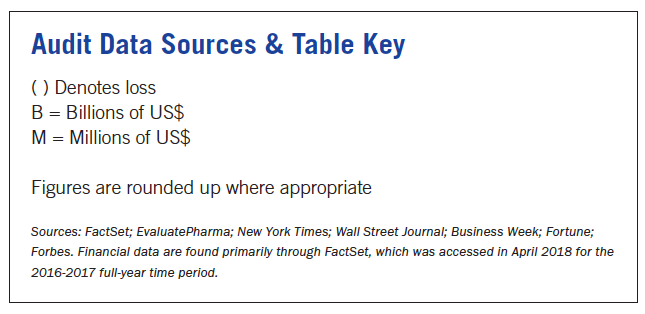
Three metrics are included that are not weighted: sales, general and administrative (SGA), or overhead; profit per employee; and, new for this Audit, executive compensation compared to median employee wages.
The higher a company performs on a metric is reflected in a ranking based on the number of points it receives. The highest placing for each metric is 23 based on the number of firms in our Audit, and the lowest is one. For example, if a company places 22 (second highest) on the critical metric enterprise value to sales (EV/S), it receives 66 points on that metric (22 rank × weight of 3 = 66). In another example, if a company comes in at a ranking of five (five places from the bottom) on the metric gross margin (pricing power), its total points would be 10 (5 ranking × weight of 2) on that metric.
Each of the 23 company’s points-based placement per metric are totaled to arrive at an overall ranking to determine which of the 23 receives the most points to become this year’s winner.
Indices
Basic indices are the growth of the US economy and inflation. A company has to be able to grow faster than the US economy: slightly below 3% in 2016 and higher than inflation as measured by the Consumer Price Index (CPI)-about 2% for 2016. Then there are more specific indices related to economic performance such as the Dow Jones, Standard & Poor’s, Nasdaq, and other “macro” benchmarks.
Sales growth
Table 1 shows sales in US dollars along with sales growth for 2016–2017. It is good to grow, especially organically, compared to just acquiring companies. But that’s easier said than done for companies at absolutely high sales levels, such as Johnson & Johnson, Novartis, and Roche. The poster firm for growth is Amazon.

Amazon’s profits pale in comparison to their competitors, such as Walmart, but its enterprise value (EV), or market cap, is the envy of its peers, less stellar sales growth, notwithstanding.
The average dollar sales for our pharma 23 was $26.87 billion in 2017, vs. $25.90 billion in 2016, a growth rate of 3.7%. That rate outpaced the US economy and inflation and the Fortune 500. Five companies’ sales decreased last year.
Assuming Shire is categorized as a biotech, given its thrust toward orphan diseases, biotechs’ growth rates exceeded the pack, with Shire, Regeneron, Celgene, and AbbVie at the top. For the so-called big pharma, GlaxoSmithKline, Lilly, Bristol-Myers Squibb, and J&J set the pace.
The sales growth winner for generics was Mylan, followed by Teva, and then with a negative growth rate, Endo.
Enterprise or shareholder value and growth
This is the first of the three crunch metrics. EV/sales and ROIC are the others. There are other worthy performance metrics, e.g., corporate responsibility; sustainability; the best places for women and minorities to work; etc, but our focus is financial performance.
EV is the sum of a company’s market capitalization; then add in debt and subtract a firm’s debt after adjusting for cash and other current assets. Simply put, EV is the market value of an organization. At present, two firms
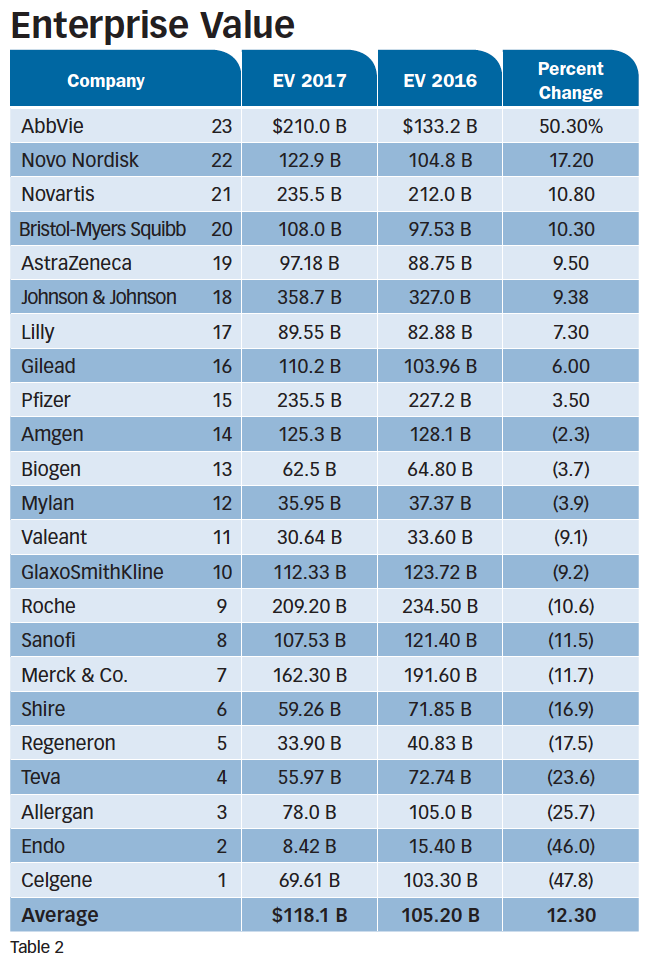
are fighting it out for the highest company value on earth: Apple and Amazon, with Apple recently eclipsing $1 trillion in market cap and Amazon approaching that milestone.
Table 2 shows that the pharma with the highest EV is J&J at $359 billion, with an average growth for the year of 9.38%. The company that grew its EV the most is AbbVie, with a 50.3% growth rate. To put that in perspective, the average EV for our 23 for the past year was $118 billion, vs. $105 billion for 2016, a growth rate of 12.3%. Only nine firms on our list increased shareholder value, while 14 experienced decreasing EV. Novo Nordisk comes in at number two with an impressive 17% EV growth rate, but AbbVie’s rate was three times greater.
Our 23 pharmas’ average shareholder value of 12.3% compares to other indices as follows:
- 28.2% Nasdaq Composite
- 25.1% Dow Jones Industrial Average
- 20.0% S&P 500 Healthcare
- 19.0% S&P 500
These indices performed better in 2017 compared to 2016, but the bleak EV showing for the majority of our 23 pharmas suffered in comparison the past year. Other than Novo Nordisk and Gilead, big pharma performed better than biotech. The three generic companies came in negatively, with Mylan experiencing the least loss.
Enterprise value to sales
EV and EV growth are very important performance metrics. EV to sales supplements that metric by assessing which firms are still climbing, vs. companies whose best performance is behind them, via so-called “value” stocks-those stocks for widow and orphan drugs that, if not growing in value, still pay noteworthy dividends.
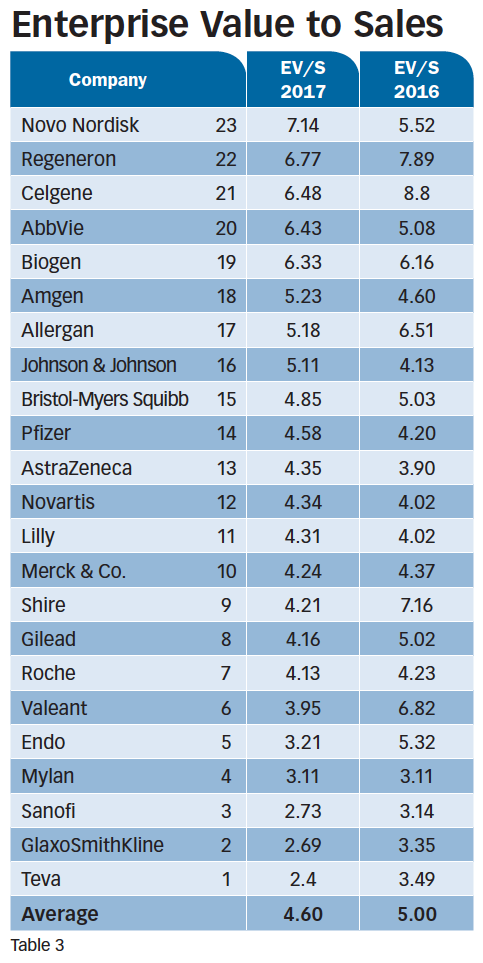
Table 3 lists EV to sales. The average EV/S for 2017 is 4.60, a decrease from 2016’s 5.00, shadowing the drop in EV growth. Compared to the Fortune 500, our 23 pharmas’ EV/S numbers are higher. Plugging in the Fortune 500’s market cap to sales, an approximation for EV/S, shows the figure for 2017 at 1.68, vs. 1.55 for 2016; but the Fortune 500 numbers increased over the year, in contrast to our 23 pharmas’ decreasing EV/S. At the top is Novo Nordisk, increasing from 2016’s 5.52 to 7.14. Similar to Table 2, only nine companies increased their EV/S ratios; the higher the ratio, the more likelihood the firm’s performance is going to get better. The top six performers are biotechs, although Regeneron and Celgene went backwards.
Of the big pharmas, J&J, Pfizer, AstraZeneca, Novartis, and Lilly showed respectable numbers. Endo’s EV/S was the highest among the generics, followed by Mylan and Teva, respectively.
Gross margin
Yes, there is net-net and list price vs. net price, but at the end of the day, there is gross margin, which is tantamount to markup. As Warren Buffet would call it, “the moat around your castle.”
Gross margin is total revenue minus cost of goods sold from the income statement. This is quintessential margin management: how price is managed while simultaneously managing operating costs to produce net income. The higher the gross margin is, the more a firm is able to cover operating expenses, including SGA. Table 4 shows Celgene at the top, with a nose-bleed gross margin of 93.80%, increasing from 2016. The biotechs rule pricing as they have ever since the first PE Industry Audit in September 2002. According to The Wall Street Journal’s
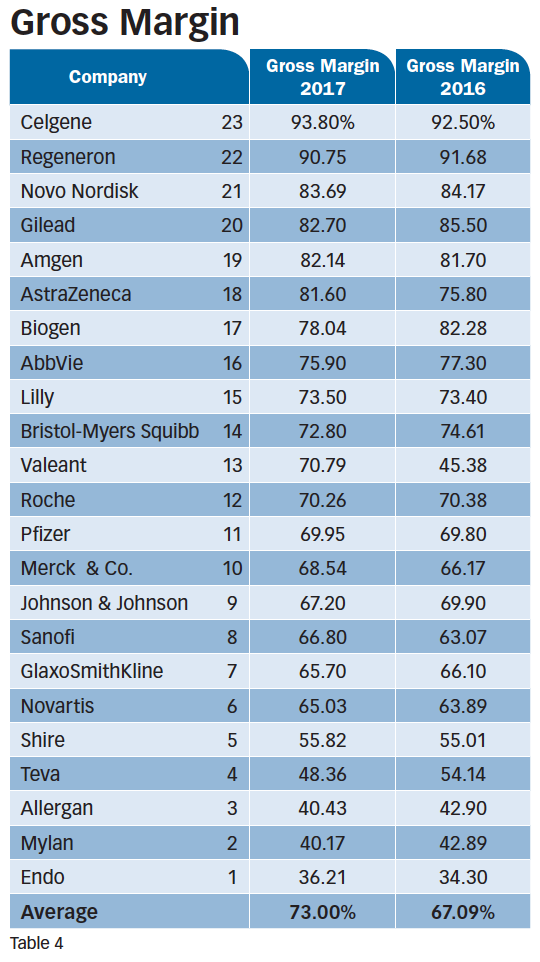
William Galston, between 1980 and 2016, US firms have increased markups by 42%; for biotechs, the markup growth has been 419%.
For the big pharmas, Lilly ranked at the top in gross margin, followed by BMS, Roche, Pfizer, Merck & Co., and J&J. The average gross margin for 2017 was 73%, up from 67.09% the year before. Nine companies grew their gross margins.
For the generics, Teva’s margin was highest, followed by Mylan and Endo, but of the three, Endo was the only one to increase its output in this metric. The biggest increase in gross margin goes to Valeant, whose figure went from 45.38% in 2016 to 70.79% a year later, within stalking distance of biotech Biogen’s margin of 78.04%.
Operating income
Staying with margin management, Table 5 shows operating income, or profit to sales. Again, the higher gross margin is, the more that contributes to improving operating income. Operating income consists of total revenues minus cost of goods sold and minus operating expenses related to a firm’s typical business. It excludes one-time gains and losses, dividend income, and interest income.
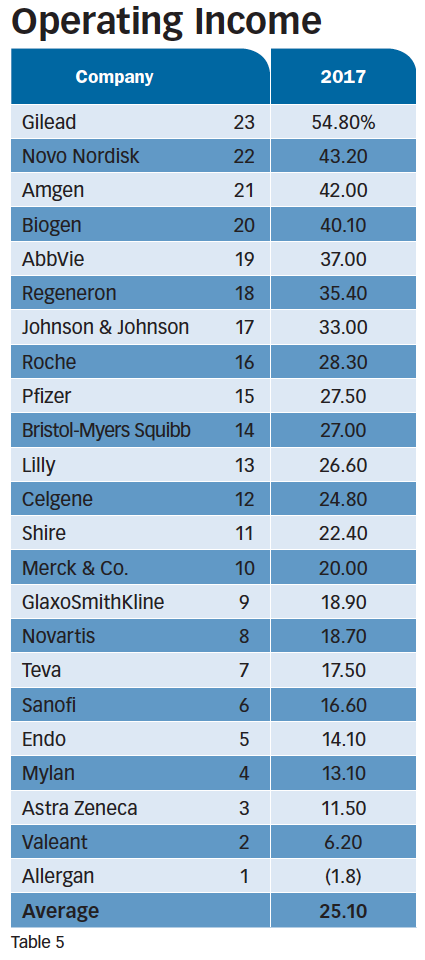
At the top in this metric is Gilead at 54.8%, a drop from 60.7% in 2016. Still, most companies would envy that number, which for the majority of firms would be their gross margin, not net income. The average operating income for 2017 was 25.1%, a slight drop from 25.9% in 2016. Only five companies saw their operating incomes increase for the year. Not surprisingly, given their staggering gross margins, the biotechs reside at the top of the operating income pack. The big pharmas are led by J&J at 33%, 30% above average, but no mean feat given its large sales volume from lower- priced, over-the-counter products. The biggest increase goes to Lilly at 20%.
For the generics, Teva ranked the highest in operating income, followed by Endo, which saw its numbers increase by more than 20%, and Mylan.
Sales to assets
Gross margin and operating income have to do with margin management; sales to assets has to with asset management. If a firm is at $70 billion in sales, it won’t be doubling revenue anytime soon. If the company has also curtailed SGA and disposed of assets, it won’t be cutting operating expenses in half anytime soon either. Then it turns to asset management to do a better job making use of, not necessarily owning, assets. When you multiply profit to sales (operating income) by sales to assets (asset management), you get a far more important measure: return on assets. A firm can have a relatively low profit margin with a relatively high sales-to-
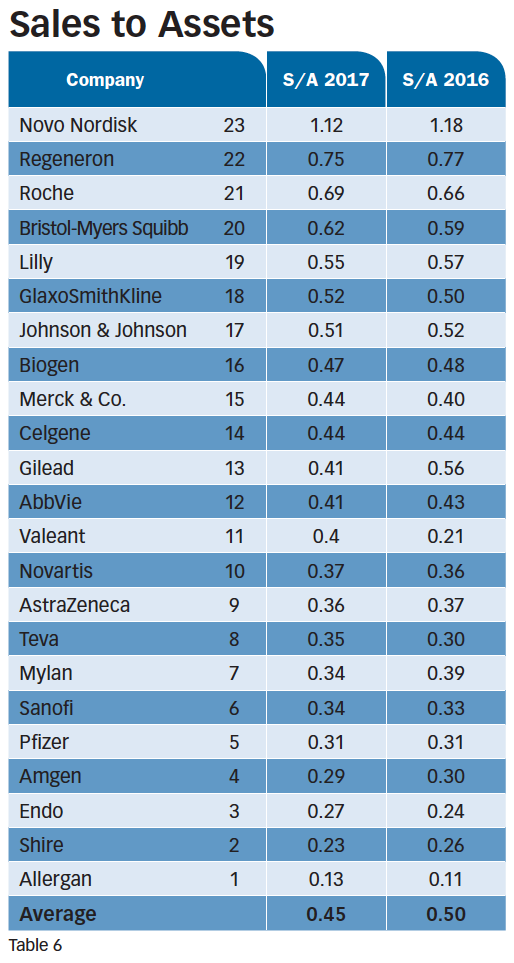
assets ratio that will result in a better performance in terms of ROIC. For example, Regeneron’s profit margin is lower than J&J’s; but its sales to assets is considerably higher, so its ROIC is higher than J&J’s.
As seen in Table 6, Novo Nordisk’s sales-to-assets ratio is 1.12. For every dollar invested in assets, Novo Nordisk gets back $1.12 in revenue. Conversely, Allergan’s ratio is 0.13. For every $1 invested in assets, the company gets back only 13 cents. Novo Nordisk is substantially more productive in managing its assets.
One would expect the generics to lead the pack here, but that is not the case. Teva, Mylan, and Endo’s sales-to-assets ratios come in at 0.35, 0.34, and 0.27, respectively.
Return on invested capital
Now we come to the mother of all metrics: ROIC. ROIC is net income left over to shareholders as a percent of debt and common stock. According to longtime organizational consultant Mark Van Clieaf in The New York Times, the best measure of business performance is ROIC-how much is a company generating on its capital investments, plant and equipment, minus the cost of that capital, debt, or equity? Combine this with our new Audit addition, weighted average cost of capital (WACC). Management should be providing value that exceeds its cost of capital, Van Clieaf contends. For example, two companies can have an ROIC of 10%; but company 1 has a WACC of 12% while company 2 has a WACC of 7%. The first firm is destroying shareholder value while the second is creating shareholder value.
Prior to the mid-1980s, the conventional wisdom was that debt had a cost (the rate paid for borrowing), but issuing stock was free. But what if the peer groups a company competes with have a higher ROIC? Even though the firm shows a profit, it is destroying shareholder value if its profit is below its peers’ average. What return could an investor get by investing in a company of equal risk? This was the brainstorm of Stern Stewart, a consulting firm based in New York City.
My source for WACC relies on three years of income statements and balance sheets to arrive at a company’s WACC percentage.
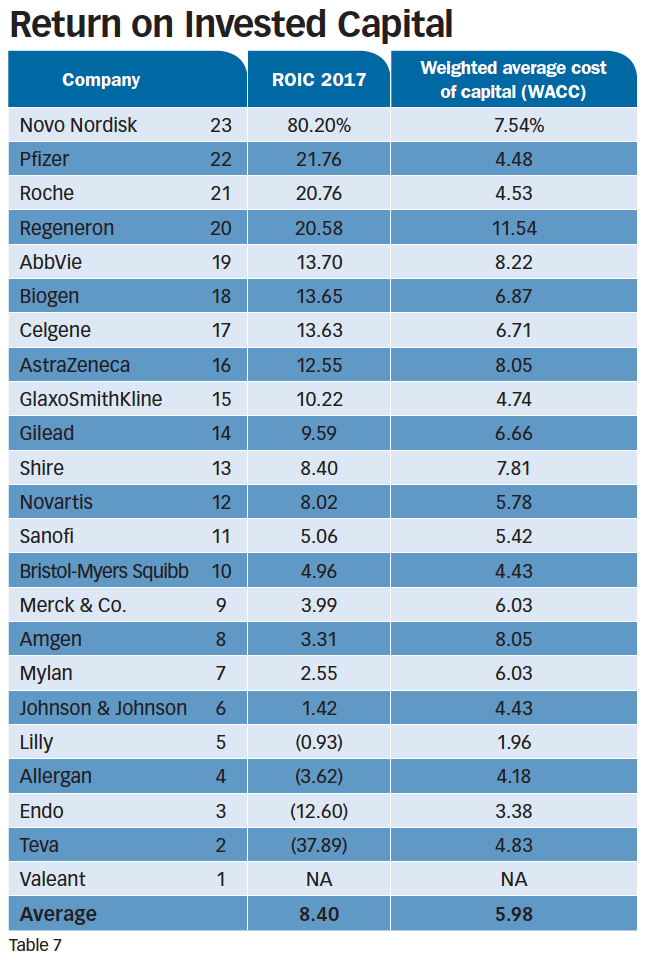
Table 7 shows Novo Nordisk far out in front with an ROIC of 80%. Second place goes to Pfizer, at 21.76%. For the generics, Mylan is the only one with a positive ROIC, at 2.55%, with negative numbers for both Endo and Teva.
To avoid overstating the impact of ROIC, we use the ROIC number to come up with the rankings on this metric. But the inclusion of WACC in Table 7 tells an interesting story. The greater the difference between ROIC and WACC, the greater the return to shareholders. And, again, Pfizer has an ROIC of 21.76% but a WACC of only 4.48%. With the exception of Pfizer, the biotechs dominate the creation of shareholder value. Ten companies had higher WACCs than ROICs, resulting in loss of shareholder value for those firms.
Net profit per employee
This metric, presented in Table 8, is not weighted in the rankings. But it is interesting to show how profitable the pharma sector is. Of our 23 pharmas, Gilead produces the most profit per employee, at $462,800 per employee. That is quite a drop from 2016’s $1.5 million total, but not bad
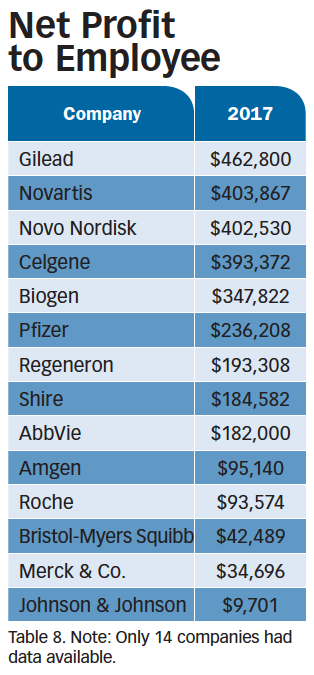
compared to Apple’s profit per employee in the same range. Only 14 companies had net profit per employee data available.
Selling, general and administrative expenses to sales
SGA is another metric that does not impact the rankings. Nonetheless, it is still important because the expenses in this category are necessary to run an organization and constitute routine spend such as rent, salaries, advertising, marketing, legal, and more. Laying off and firing workers costs money in severance before it begins to pay off. It’s also important to keep in mind that this is a one-year comparison. A firm can be making investments in advertising, training its sales force, etc., and that will pay dividends down the road. One swallow does not a season make.
For example, according to a recent article in Fortune,Costco’s SGA is 10% compared to Walmart’s 20%. That partly enables Costco to operate on a markup of 11% to Walmart’s 24%. Opportunities exist to cut advertising costs by being more efficient with agencies and revamping supply chains. Also, SGA can increase, but it is the goal for sales growth to grow faster, thereby lowering the SGA-to-sales ratio. Ballooning overhead leaves a firm inefficient and less productive than it otherwise could be.
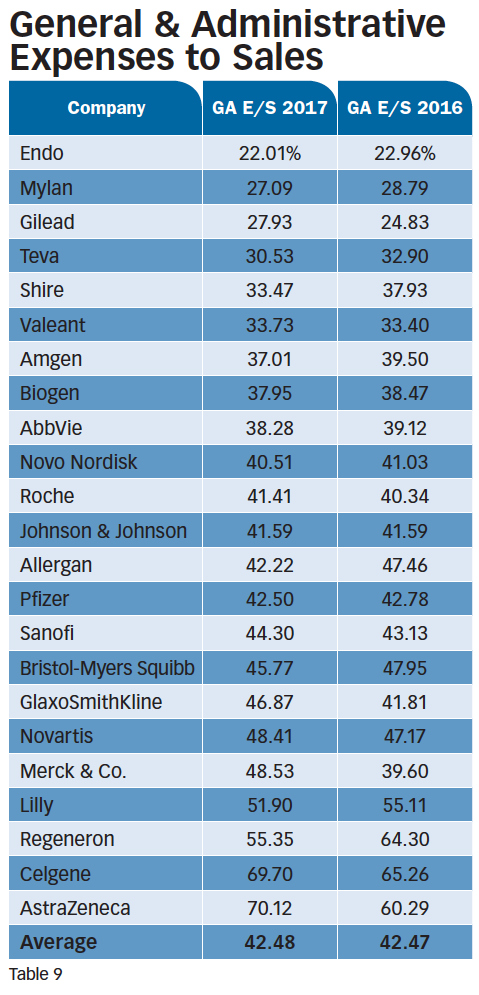
Table 9 shows the generics are lean and mean on this metric, with Gilead the third lowest of our 23 pharmas. The average SGA for 2017 was 42.48% of sales, vs. 42.47% for 2016. GSK, Merck, and AstraZeneca had the
biggest year-to-year increases in SGA to sales. And, again, this may have much to do with new product launches and investment in sales training and education. AstraZeneca’s SGA/sales is the highest, at 70.12%. If AstraZeneca were able to lower SGA/sales to the 42.48% average, this would add about $5 billion to retained earnings or to invest in R&D.
Executive compensation to median employee wages
As mentioned, this measure is new for this year’s Audit. From a larger societal perspective, we are seeing, globally, an increase in the top 1% of income compared to the average worker. The Gini coefficient measures this increasing wealth distribution disparity. A score of 1.0 reflects high income inequality; a score of zero reflects no inequality. The lower the Gini coefficient, the more equal the distribution of wealth; the higher the score and closer to 1.0, the rich get richer and the middle class and the poor get poorer. The Scandinavian countries tend to hit more equitable distributions of wealth. Mexico and South Africa are among the highest scores, reflecting very unequal differences in wealth, with the US moving more in that direction.
Analogously, there is a similar interest emerging in the difference between executive compensation and the median wages of workers. This year, for the first time, thanks to the Dodd-Frank Wall Street Reform and Consumer Protection Act, companies are disclosing what their CEOs make vs. the median wages of their employees. Recent research from two academics reveals that the average CEO/median worker pay ration has
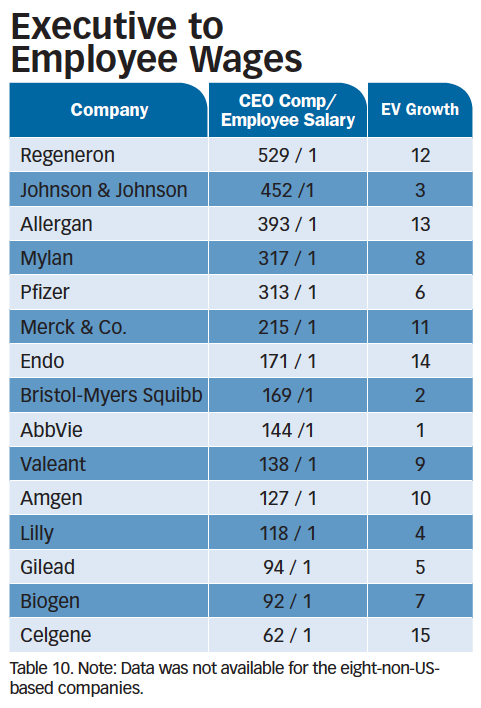
soared from 30 to 1 to more than 300 to 1 over the last 40 years. According to The Wall Street Journal’s Patrick Thomas, the median CEO pay in 2017 for 25 biotech, pharma, and life sciences CEOs was $16.08 million, above the overall median of $12.1 million for all S&P 500 companies.
Recently, The New York Times published the Equilar 200 Highest-Paid CEO rankings. Equilar is an executive compensation consulting firm. Table 10 shows the rankings for 15 US-based pharma firms; no executive compensation was available for the eight-non-US-based companies. The highest-paid CEOs aren’t necessarily associated with outstanding financial performance. The highest ratio was Regeneron, at 529 to 1; the company came in 12th out of the 15 US-based biopharma firms in our Audit in terms of EV growth. Celgene had the lowest ratio, at 62 to 1; the company also generated the lowest growth in EV. The organization with the highest growth in EV was AbbVie, at 50.3%, while its CEO had a compensation/worker ratio of 144 to 1, which ranked 9th.
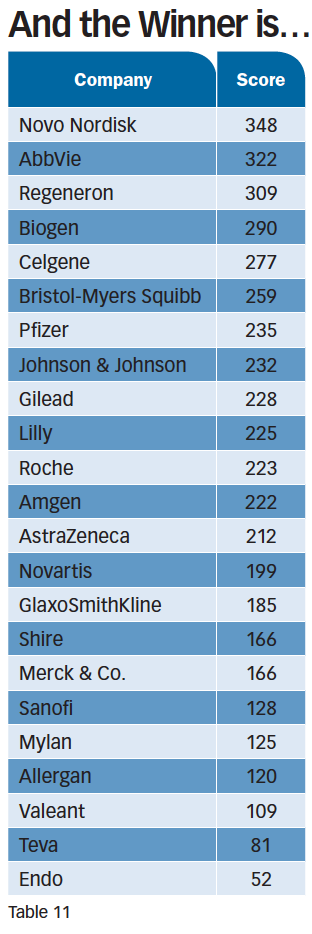
Final tally
Table 11 reveals the winner of this year’s Audit: Novo Nordisk. AbbVie comes in second, followed by Regeneron, Biogen, and Celgene rounding out the top five. We are in good company recognizing Novo Nordisk’s performance. EvaluatePharma, in its World Preview 2018, also lauds Novo Nordisk on its investment in R&D and M&As, along with its focused strategy resulting in superior return on investment. BMS, Pfizer, J&J, and Lilly lead the big pharmas in point totals in our Audit. Mylan beats out Teva and Endo for the generics honor.
Bill Trombetta, PhD, is Professor of Healthcare Strategy & Marketing at St. Joseph’s University Haub School of Business in Philadelphia. He can be reached at trombett@sju.edu
Biopharma vs. high-tech; click to enlarge
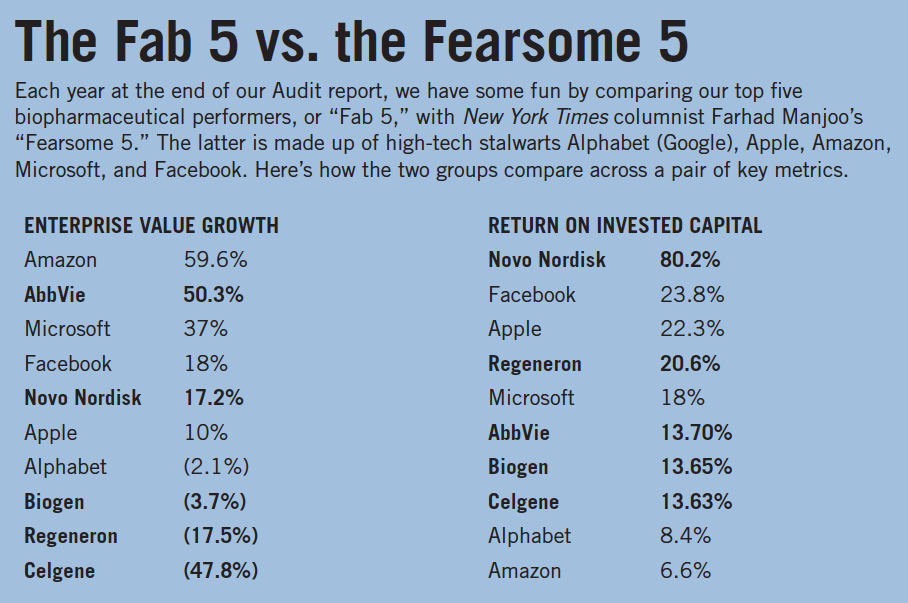
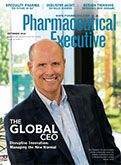
Regeneron, Roche Launch Major US Expansion Plans to Meet Growing Demand for Biologics and Innovation
April 22nd 2025With combined investments exceeding $53 billion, both companies are deepening their US presence through expanded biologics production, gene therapy capabilities, and next generation R&D centers.
Cell and Gene Therapy Check-in 2024
January 18th 2024Fran Gregory, VP of Emerging Therapies, Cardinal Health discusses her career, how both CAR-T therapies and personalization have been gaining momentum and what kind of progress we expect to see from them, some of the biggest hurdles facing their section of the industry, the importance of patient advocacy and so much more.